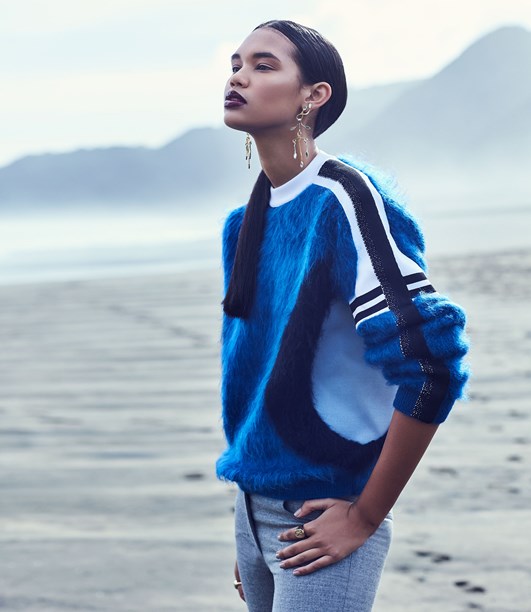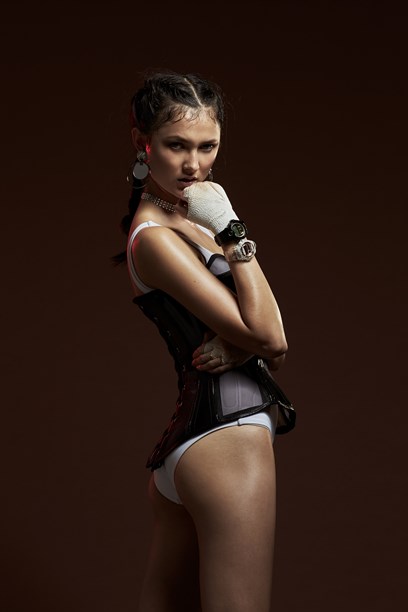Stories
Stephen Tilley
1973-

When Stephen Tilley picked up his first camera, a Kodak Box Brownie, he unwittingly connected his story to that of Diana, Princess of Wales, seeding an eerie thread cascading through his now more than 18-year fashion photography career.
"I was about 10 and it was one of the first shots I ever took. It was of Lady Diana and Prince Charles when they were here visiting the colonies. My parents gave me the camera especially for that occasion."
Then on 31 August 1997, the night Princess Diana died, Stephen landed in London. "The next morning I woke up to the shocking news and immediately grabbed my camera and headed to Kensington to capture this historic moment in time. I was faced with women screaming, wailing and attacking me because I resembled a paparazzi photographer with my professional camera. Everyone was blaming the paparazzi for Diana's death. It was an extraordinary scene, I never really expected."
From London Stephen travelled through Europe building a portfolio of personal creative work. These images were noticed by Caroline Brown, now his partner and the owner of PROCESS Studios, who was establishing a street culture magazine. Caroline offered him a position as 'photographer' for the publication and so began his professional photography career in 1999.
Caroline was based in a building called the Truman Brewery in Brick Lane in the west end of London as it was emerging as a hub for the creative sector. Cheap rent attracted artists, stylists, photographers, designers, model agency, record labels, musicians and recording studios. Downstairs in the Vibe bar everyone from Goldie, Grooverider, Pete Townsend, Liam Gallagher, Patsy Kensit, Billy Corgan and Madonna were present for evening and Sunday afternoon sessions.
This environment fuelled Stephen’s early photographic ambitions. He spend his days shooting the London Street culture and the evenings scanning prints and learning photoshop. He became the public relations photographer for the Truman Brewery building owner which led to shooting at London Fashion Week over two consecutive years (1998-99) where he had access to the shows and met designers like Alexander McQueen.
It was here that Stephen’s photographic career crossed paths for the first time with the New Zealand fashion scene, meeting Margarita Robertson of NOM*d and Liz and Neville Findlay of Zambesi at the 'after party' for the 'New Zealand Four when Karen Walker, NOM*d, Zambesi and WORLD showed at London Fashion Week, sponsored by Wools of New Zealand. The following day, he captured an iconic image in New Zealand fashion history when he photographed NOM*d’s Margarita Robertson and Zambesi’s Liz Findlay crossing Oxford Street with their clothing rack on their way to deliver their new collection to their PR Company, Concret.
Returning from London to Wellington in 2000, Stephen shot a series of portraits in Thailand. These images, contrasted with portraits shot at London Fashion Week, became an exhibition at the Michael Fowler Centre. Sponsored by NOM*d and Zambesi, it drew strong media attention gaining exposure on television, radio and print and was well attended by Wellington’s leading creatives and business communities heralding an auspicious homecoming.
In an ironic touch, the following week, Dresses for Humanity, a touring exhibition of 18 of Princess Diana’s dresses, was opened at the same venue.
Following on from his inaugural exhibition Margarita Robertson and Stephen became good friends and worked together on a number of campaigns for NOM*d. The first was photographed at one of Wellington’s landmarks, the home of the architect, the late Ian Athfield.
While Stephen is known for his journalistic style and his ability to capture the fluidity and looseness of movement, it is his fascination with people and their most raw and real moments that draws him in. "I like to tell a story that’s honest. I look for realism in photos, I look for an energy, I don’t like to overly pose the models or force them into awkward situations. I like to let the model - particularly a good one - have their own personality come through."

Image © Stephen Tilley.
Stephen’s personable skills allows him connect with his subject to capture these real moments and it was this quality that he, alongside talent scout and agent, Amanda Betts, brought to his shoot with the then undiscovered, Zippora Seven. The photos were shot against a wall with Zippora, shy and shell-shocked at her first shoot. Stephen delivered images that ended up on the cover of Pavement.
That early rapport led to many more successful shoots and she became one of his favourite models. Unsurprisingly, Stephen has shot the hall of fame of New Zealand’s top models, among them Rachel Hunter, Kylie Bax, Penny Pickard, Georgia Fowler, Holly Rose Emery, Emily Baker, Maia Cotton, Teresa Moore, Juliette Perkins, Eden Bristow and Liv O'Driscoll.
He has worked for some of New Zealand’s leading magazines, among them Pavement, Remix, Fashion Quarterly, Urbis, Denizen, Metro, MiNDFOOD, MiNDFOOD Style and international titles, i-D (the iconic issue), Sportswear International and C-Heads.

Stephen Tilley photograph for Remix magazine. Image © Stephen Tilley.
With no formal training Stephen’s photographic career began with that Box Brownie and later by traipsing around Wellington with a camera together with a friend who had studied photography. He learnt by experience supplementing that with knowledge gleaned from reading photography books to understand the technicalities. He says that his photographic aesthetic evolution is inextricably intertwined with that of New Zealand fashion. He believes New Zealand’s place at the edge of the world powers our unique fashion expression, and he questions whether a globalised digital world could erode that. His distinct editorial style, has been inspired by New Zealand photographers Derek Henderson and the late Craig Owen’s work for Fashion Quarterly. Influences from Rolling Stone magazine to street culture and the 1990s dance music scene have also filtered into his photography.
"I’ve always been inspired by rock 'n' roll photography; the imperfect beauty and the-day-after-the-night-before Corinne Day aesthetic that to this I day I still love."
Having shot campaigns for NOM*d, Crane Brothers, Company of Strangers, Taylor, Superette, Deadly Ponies, Lonely, Juliette Hogan, Kathryn Wilson, Standard Issue, Trelise Cooper, Moochi, Caroline Sills, Loobie’s Story, Max and Barkers his photographic output has formed an integral part of the New Zealand fashion story of the last two decades.

Stephen Tilley's photograph for Moochi, 2016. Image © Stephen Tilley.
Stephen believes, even since the early 1990s, that he’s maintained the core qualities of his work, saying that "obviously" he’s become more technically sound.
Digital photography has allowed him to be free. When he began he had just 36 shots per one outfit, so had to "freeze the model into position", an era he’s happy to leave in the lap of nostalgia. His latest 'digital' camera shoots twelve frames per second, and is he says "probably the first camera that I could ever say has made me a better photographer. Shooting multiple frames allows me to shoot through a whole moment and pick that perfect moment out of it rather than having to get that split second right. It allows the model to express themselves more, which has been a hallmark of my work."
Text by Belinda Nash. Banner image © Stephen Tilley.
Last published May 2017.